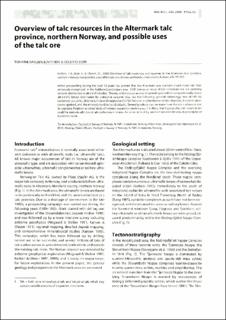| dc.contributor.author | Karlsen, Tor Arne | |
| dc.contributor.author | Olesen, Odleiv | |
| dc.contributor.author | Rian, Edvin | |
| dc.coverage.spatial | 19271 Mo i Rana | |
| dc.date.accessioned | 2020-08-26T09:08:53Z | |
| dc.date.available | 2020-08-26T09:08:53Z | |
| dc.date.issued | 2000 | |
| dc.identifier.uri | https://hdl.handle.net/11250/2674217 | |
| dc.description.abstract | Active prospecting during the past 10 years has proved that the Altermark area contains much more talc than previously recognised in the Nakkan-Esjeklumpen area, 10 M tonnes or more of talc-carbonate ore are probably present, distributed in ultramafic bodies. The ore, which occurs as one of several layers within compositionally zoned ultramafic lenses dominated by antigorite serpentinites, has the following general mineralogy; talc (45-65%), carbonate (30-50%), chlorite (0-4%) and magnetite (0-3%). Relative to other known similar deposits, the ore is rather coarse-grained, and the minerals tend to be idio- blastic. Several products can be made from the talc-carbonate ore. By applying flotation or other kinds of mineral separation techniques, it is likely that high-quality talc-concentrate could be made in addition to calc-carbonate mixtures. a concentrate of by-product breunnerite would possibly be of ecomonic value. | |
| dc.language.iso | eng | |
| dc.relation.ispartofseries | NGU Bulletin (436) | |
| dc.rights | Navngivelse 4.0 Internasjonal | |
| dc.rights.uri | http://creativecommons.org/licenses/by/4.0/deed.no | |
| dc.subject | TALK | |
| dc.subject | MINERALFOREKOMST | |
| dc.subject | MINERALOGI | |
| dc.subject | SERPENTINITT | |
| dc.title | Overwiew of talc resources in the Altermark talc province, northern Norway, and possible uses of the talc ore | |
| dc.type | Journal article | |
| dc.description.localcode | 49532 | |
| dc.source.pagenumber | 93-102 | |

